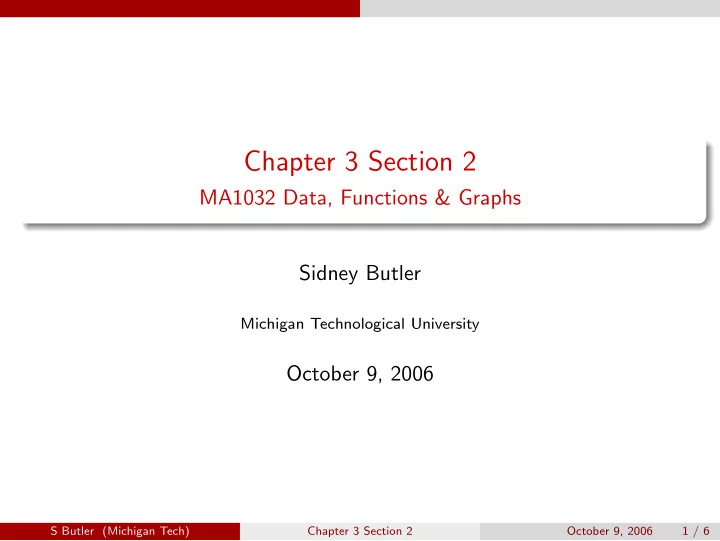

Chapter 3 Section 2 MA1032 Data, Functions & Graphs Sidney Butler Michigan Technological University October 9, 2006 S Butler (Michigan Tech) Chapter 3 Section 2 October 9, 2006 1 / 6
Example 1 2 4 5 8 9 x f ( x ) 4096 1024 64 16 0.25 0.0625 S Butler (Michigan Tech) Chapter 3 Section 2 October 9, 2006 2 / 6
Example At time t = 0, a species of turtle is released into a wetland. When t = 4 years, a biologist estimates there are 300 turtles in the wetland. Three years later, the biologist estimates there are 450 turtles. Let P represent the size of the turtle population in year t . 1 Find a formula for P = f ( t ) assuming linear growth. Interpret the slope and P -intercept of your formula in terms of the turtle population. 2 Now find a formula for P = g ( t ) assuming exponential growth. Interpret the parameters of your formula in terms of the turtle population. 3 In year t = 12, the biologist estimates that there are 900 turtles in the wetland. What does this indicate about the two population models? S Butler (Michigan Tech) Chapter 3 Section 2 October 9, 2006 3 / 6
Problem #28 Suppose f ( − 3) = 5 8 and f ( t ) = 20. Find a formula for f assuming it is: 1 Linear 2 Exponential S Butler (Michigan Tech) Chapter 3 Section 2 October 9, 2006 4 / 6
Comparing Growth Rates 80 70 60 50 y=5x+20 40 30 20 y=3(1.08)^x 10 0 1 2 3 4 5 6 7 8 9 1 S Butler (Michigan Tech) Chapter 3 Section 2 October 9, 2006 5 / 6
Summary 1 Determining linearity 2 Determining exponentials 3 Exponential Formulas S Butler (Michigan Tech) Chapter 3 Section 2 October 9, 2006 6 / 6
Recommend
More recommend